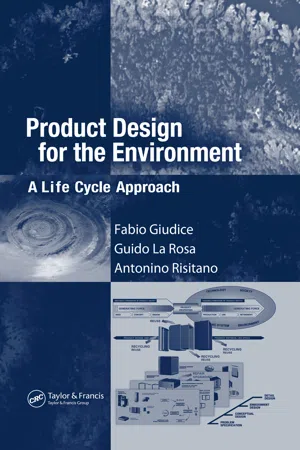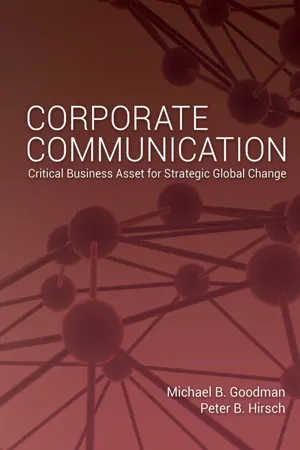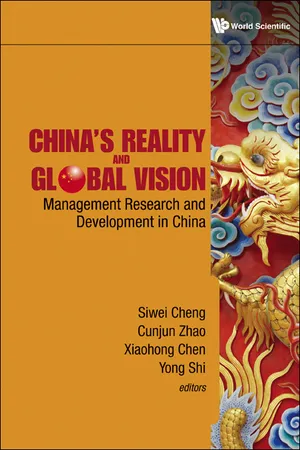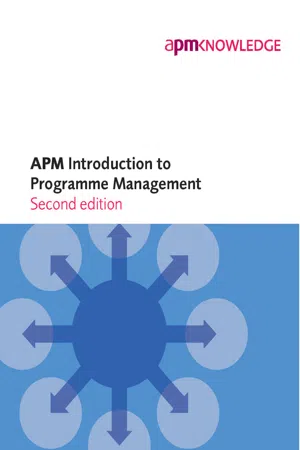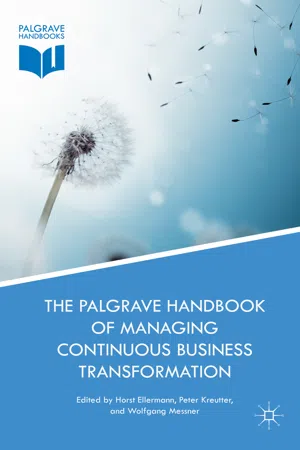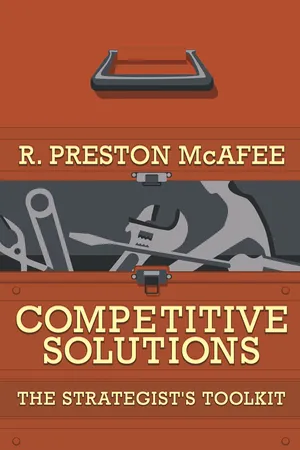Business
Business Life Cycle
The business life cycle refers to the stages that a business goes through from its inception to its eventual closure. These stages typically include the startup phase, growth, maturity, and decline. Understanding the business life cycle can help entrepreneurs and business owners make informed decisions about strategy, resource allocation, and succession planning.
Written by Perlego with AI-assistance
Related key terms
1 of 5
9 Key excerpts on "Business Life Cycle"
- eBook - PDF
Product Design for the Environment
A Life Cycle Approach
- Fabio Giudice, Guido La Rosa, Antonino Risitano(Authors)
- 2006(Publication Date)
- CRC Press(Publisher)
At the base of this accep-tance of the life cycle concept as an analytical model for such widely varying phenomena, there is the understanding that both production activities and technologies, and products themselves, theoretically develop following an evolutionary path passing through different phases. With regard to products, this evolutionary perspective is now well-rooted in the field of marketing (Massey, 1999). In the context of the management of products in relation to market dynamics, in fact, the life cycle is understood as the period during which the product is on the market. This period consists of four successive phases: introduction, growth, maturity, and decline. In this context, the objective of Life Cycle Theory is to describe the behavior of the product from development to retirement, to optimize the value of and the potential for profit in each phase of the cycle (Ryan and Riggs, 1996). With this aim, life cycle becomes a representation of the product’s market history and each phase is characterized by the trend of the sales volumes and profit performance (Cunningham, 1969), so as to guide the decisional choices of management regarding possible intervention strategies (marketing actions, pricing, service strategies, product substitution, etc.). In the same limited field of marketing, the breadth of the potential offered by the life cycle approach has been clearly described by D.M. Gardner: “[P]roduct life cycle is an almost inexhaustible concept because it touches on nearly every facet of marketing and drives many elements of corporate strategy, finance and production” (Gardner, 1987). Likewise, the conceptual premises of Life Cycle Theory summarized above evidence the potential for its use in the management of other aspects of a product, as well. - eBook - PDF
Corporate Communication
Critical Business Asset for Strategic Global Change
- Michael Goodman, Peter B. Hirsch(Authors)
- 2015(Publication Date)
The Life Cycle of the Corporation Rebirth Revival Performance Birth, Start-up & Formation Growth & Stability Maturity & Decline Destruction & Death Time Figure 3.2 Five Phases of the Lifecycle of the Corporation. Birth or Start-up and Formation Phase At the beginning or the birth of a corporation, the organization is driven by the simple instinct to survive. Companies have to overcome the challenge of market acceptance and pursue one niche opportunity. At this stage the focus is on aligning the business opportunity with the company skills, experience, and passion. The leap from the initial idea or concept for the busi- ness (often called the seed stage) to the actual formation and financing of the corporation requires the attraction of seed money or venture capital. That quest for financing has become mythologized by numerous books and movies such as The Social Network (2010). With no proven market or customers the owners may need to rely on their own money, as well as cash from friends and family. Other potential sources might include suppliers, customers, govern- ment grants, and banks. A corporation in this beginning phase may operate on “gut” reactions rather than planned actions. It decides on a business ownership structure and looks for professional advisors. It certainly plays to win, and it is constantly learning from its experiences and adapting its actions accordingly. It can be accurately described as entrepreneurial, operating by trial and error, adapt- ing and changing, and taking risks. The corporation is on a quest for success. And attaining success pardons a multitude of mistakes, errors, and false starts. THE LIFECYCLE OF ORGANIZATIONS AND THE ROLE OF CORPORATE COMMUNICATION | 37 Tracy Kidder chronicled such innovative and creative behavior in his Pulitzer Prize- winning book The Soul of a New Machine in the early 1980s as he followed the software engi- neers at Data General Corporation as they created a new micro-computer. - eBook - PDF
China's Reality And Global Vision: Management Research And Development In China
Management Research and Development in China
- Siwei Cheng, Cunjun Zhao, Xiaohong Chen(Authors)
- 2011(Publication Date)
- World Scientific(Publisher)
Rofik, A., Jean, B., and Nicolas, L.P., 2004. An explanation of the life span of new French firms. Small Business Economics , 23, 237–254. Silviano, E.-P. and Juan, A., 2006. Manez-Castillejo. The resource-based theory of the firm and firm survival. Small Business Economics . Stinchcombe, F., 1965. Social structure and organizations. Handbook of Organi-zations . Rand McNally, Chicago. Su, Q. and Li, X., 2004. The interior government, external environment and the life cycle of Chinese family business (Chinese). Management World , (10), 85–96. 171 Study on Identification of Product Life Cycle Based on Fuzzy Diagnosis Model ∗ Hong Zhao, Zheng-Yang Zhao and Yuan Jiang Management School of Graduate University, Chinese Academy of Sciences, Beijing 100190, China A product life cycle refers to the entire evolving process of a product from it entering the market to its seceding. Only by accurately analyzing the life cycles of the products can an enterprise successfully set up conductive marketing target and relevant strategies. Based on the fuzzy recognition theory, this article builds the fuzzy membership function through the division of life cycle and discussion of recognition index. The result of the recognition model was discussed and analyzed, and then the application of this method was illustrated. Keywords : Product life cycle; Identification models; Fuzzy recognition and analysis. 1. Introduction The concept of a product’s life cycle first appeared in the field of economic management, proposed by Dean (1950) and Levir (1965), and the purpose is to examine the product marketing strategy. At that time, the product life cycle is divided in accordance with the market evolution process of the products into introduction, growth, maturity, and decline phases (Rinde and Swanj, 1979). - Association for Project Management (APM)(Author)
- 2016(Publication Date)
- Association for Project Management (APM)(Publisher)
steady-state activities The programme life cycle is aimed at establishing a firm platform for the overall change journey, whether this is for a business or societal transformation, the introduction of a new capability, or the launch of a new product into its operating environment. Figure 2.3 shows one conceptual description of this journey, illustrating the key relationships between the business objectives, the definition of the programme, the individual projects and their outputs, the programme outputs and the resulting benefits, and how these underpin the resulting business performance. 2.2 Life cycle strategy considerations Prior to the start of a programme, there may be a period of uncertainty while an organisation understands and decides that a change of some description is required and that some form of investment in change is needed. In some cases this may be a formally recognised strategic phase of activities (for example, it may be called a ‘genesis’, ‘foundation’ or ‘pre-concept’ phase), and in others it may be less clearly defined or revolutionary. In theory, all organisations should have clearly defined and agreed business change strategies, the implementation of which requires the initiation of programmes. Indeed, if the organisation is undertaking programmes within the framework of portfolio management then the programmes will be fully aligned with strategic plans. 11 Within such an environment (or where the business undertakes regular change or introduction of new complex products), the business will have defined a business change life cycle specific to its needs, and so the individual programme life cycle will have to be aligned with this generic business framework. This alignment is an important part of defining a specific strategy for the overall programme approaches, i.e- Horst Ellermann, Peter Kreutter, Wolfgang Messner, Horst Ellermann, Peter Kreutter, Wolfgang Messner(Authors)
- 2016(Publication Date)
- Palgrave Macmillan(Publisher)
A four-stage model became the dominant design in the literature, describing a product’s life cycle as the sequence of (a) introduction, (b) growth, (c) maturity, and (d) decline (e.g., Patton 1959; Levitt 1965). From the very beginning, there was a controversy around the validity of the product life cycle concept (Polli and Cook 1969). Certain authors argued against simply transferring biological thinking to management research because of its determinism (Penrose 1952). Other authors emphasized the lack of the concept’s empirical underpinning. As Dhalla and Yuseph (1976, p. 103) state: “Most writers present the PLC [product life cycle] concept in quali- tative terms, in the form of idealization without any empirical backing.” Often management consultants such as Arthur D. Little or the Boston Consulting Group, rather than academic scholars, promoted the concept (Servatius 1985, pp. 112–113). Thus, the combination of intuitively appealing predic- tions, catchy rule-of-thumb strategies, and a shortage of empirical justifica- tion found in many publications on this topic is not surprising. Academic studies trying to establish sound empirical validation of the product life cycle concept reported mixed results at best (Höft 1992, pp. 23–25). For example, Cox (1967) surveyed a sample of 754 ethical drug products introduced in the USA in 1955–1960, and Polli and Cook (1969) presented results from a sample of 140 nondurable consumer goods. Both studies’ results clearly demonstrated the limited empirical validity of the product life cycle con- cept. It took Cox (1967) six entirely different ‘basic’ types of product life cycles curves to describe the empirical patterns for different products he examined. In addition, large differences in the rate at which cycles progressed were observed, as were significant differences in skewness and kurtosis. Such problems were often found in the mature and declining phases in particular (Harrigan 1980; Hopenhayn 1993).- eBook - PDF
Stock Market Cycles
A Practical Explanation
- Steven E. Bolten(Author)
- 2000(Publication Date)
- Praeger(Publisher)
6 Industry Life Cycle Does the company’s stage in its industry life cycle affect its common stock price? Investors label common stocks and industries according to the pattern of their expected earnings. The major categories are venture capital, growth, mature, and stable/declining. Corporations and industries within these categories usually progress through the various catego- ries, from “birth to death.” This trek is the industry life cycle. INDUSTRY LIFE CYCLE The dynamic forces of a capitalist economy naturally create sig- nificant changes in the expected earnings and risk environments for corporations. New ideas come forth and develop. Unique, superior profit opportunities emerge, only to be withered away by imitating competitors. Superior profits turn average. Further new ideas come forth, develop, and turn average profits into declining profits. Entire industries disappear. The economy goes on. The birth to death life cycle repeats with different players. These dynamics are illustrated in Figure 6.1, the industry life cycle. The venture capital stage is most closely associated with the new ideas, the visions, and the aspirations yet to be attained. The rapid growth stage emerges as the vision turns to implementation. The euphoria surrounding the first success fosters rapid growth and com- Figure 6.1 Industry Life Cycle Industry Life Cycle 91 petition that ends in a shakeout of marginal players. The mature stage survivors entrench into the economic mainstream. Many become “blue chips.” Yet they are not immune to the competitive dynamics. Unless they reinvent themselves, they sink into the stable/declining stage, pushed by new venture capital stage companies. The duration of the trek through the life cycle varies among in- dustries and companies. Woolworth, for example, operated over a century and still clings on as a shadow of its former self. The five- and-dime retail store concept was held in little regard when first in- troduced. - eBook - ePub
- Kenneth Kahn(Author)
- 2014(Publication Date)
- Routledge(Publisher)
11 Life Cycle Management After launch, the product begins what is termed “the product life cycle.” The product development team is discharged at this point, if it has not already been discharged prior to launch, and a product management team (which in many cases had launch responsibility) takes over responsibility for the product. The product management team will focus on the life cycle management of the product—that is, ensuring that the product reaches its full potential as a particular product item or emerging product line in the company’s product mix. Associated with reaching this potential are decisions about fine-tuning the product’s marketing strategy, defending against competitors, and continuous innovation of the product, if feasible. Brand management considerations also will persist after product launch. The Product Life Cycle The product life cycle is a concept that attempts to describe a product’s unit sales postlaunch through its eventual termination. The curve parallels the diffusion or S-curve, suggesting product diffusion into the marketplace. The theory underlying the product life cycle is that unit sales will transition through four distinct product life cycle stages: introduction, growth, maturity, and decline (see Exhibit 11.1). The introduction stage represents the launch cycle. Here sales slowly emerge as the company tries to establish a beachhead and then early growth. The focus of the marketing effort is to create awareness and get trial. During the growth stage, sales rise steadily, and the focus becomes to maximize market share. The maturity stage represents a leveling of sales, and the focus is profit maximizing and market share maintenance. The decline stage is the final stage characteristic of decreasing unit sales - eBook - ePub
- Josef Langer, Niksa Alfirevic, J Pavicic(Authors)
- 2017(Publication Date)
- Routledge(Publisher)
Many authors believe that the ‘umbrella effect’ of the changes in the environment create both significant opportunities for disrupting the status quo, and provoke numerous new threats to the organizations that do not practice change management. These trends are even labeled as a ‘new competitive landscape’ (as defined by Bettis and Hitt, 1995, as well as by Hitt, Keats and DeMarie, 1998), which will continue to change, as well as cause further changes in societies, organizations and individuals by applying the ‘domino effect’.3.3 Stage of growth and development: Formalization of change
In the stage of growth and development , formal organizational arrangements replace the entrepreneurial approach to running an organization which is often characterized by ad-hoc solutions. Instead of ‘sticking to a dream’ and opposing what is already known, the organization in this stage of its life cycle (as described in 3.1) needs to establish rules and procedures, determine appropriate job descriptions and formal responsibilities, as well as proper approaches to managing, motivating and controlling human resources, and create a stable organizational structure and systems, etc.Such a tendency can be explained from the perspective of the ‘natural’ developments of an organization, as implied by the organizational life cycle concept. If the organization in its early stage can be metaphorically equated to the concept of change (of the environment/existing context), in the stage of growth and development, ensuring stability becomes an essential issue. Therefore, all the arrangements made throughout this stage of the life cycle should contribute to the increased predictability of the organizational behavior. Organizations, just like people, need to ‘graduate’ by becoming professional and by being perceived as ‘qualified’, in order to fulfill the expectations of all the relevant stakeholders (potential investors/donors, customers/users, suppliers and other partners, etc.).61Detailed descriptions of each formal arrangement lie far beyond the scope of this book, leaving the authors with the difficult choice of which organizational components to describe as typical of this stage. However, guidance was provided by the conviction that the (relatively) ‘new’ field of change management needs to be anchored in a ‘classic’ theory describing the patterns of change implied by different stages of the organizational life cycle. Bringing such a principle into life is clearly a reflection of A. Chandler, whose seminal work on the development of the industrial enterprise62 - eBook - ePub
Competitive Solutions
The Strategist's Toolkit
- R. Preston McAfee(Author)
- 2009(Publication Date)
- Princeton University Press(Publisher)
5Product Life Cycle
To better understand differentiation, it is useful to examine product competition from a market perspective, in what is known as the product life cycle. This traces a product from its inception through mass production to its replacement by other products. Substantial differentiation usually arises twice during the product life cycle. First, products are often improved substantially during their initial evolution, and such improvements are introduced through new variants of the product. In this case, differentiation is primarily vertical, via increases in quality. Second, a mature product may be tailored to specialized customer groups, producing a set of standard variants to the successful basic design.Historically, the product life cycle theory focused on the emergence of a dominant design. In this view, many firms initially competed with their own designs for a new product, and the research efforts of the firms were devoted to improving the product design. Competitors copied innovations and improvements, and the product design converged on a best product. As a “best” design emerged, the firms most capable of producing the best design, not necessarily the first developers of the best design, grew as a proportion of the market. A shakeout occurred as these firms grew, and the number of producers diminished significantly. After this time, the market size stabilized. A major problem with this description is that many products never have a dominant design, because consumer preferences support a variety of designs. Recent research has enhanced our understanding of the product life cycle, although there is much more to know.A large number of familiar products appear to have fit the product life cycle framework. Several of these are illustrated in figure 5.1 .1 Most of these products have periods during which the growth rate increases, followed by slowing growth. Color television (fig. 5.2
Index pages curate the most relevant extracts from our library of academic textbooks. They’ve been created using an in-house natural language model (NLM), each adding context and meaning to key research topics.
